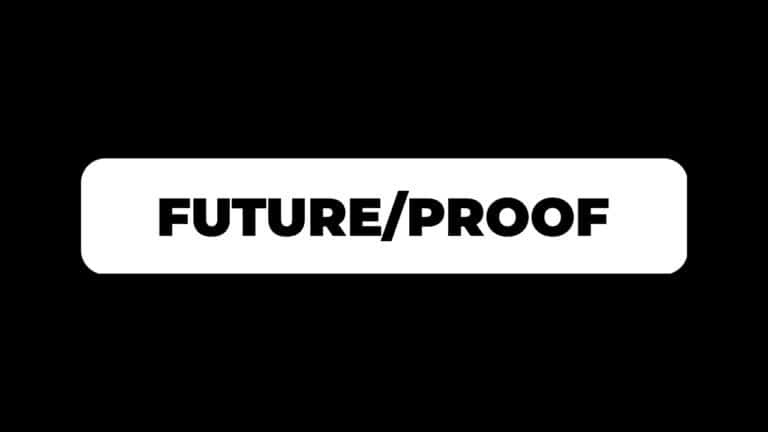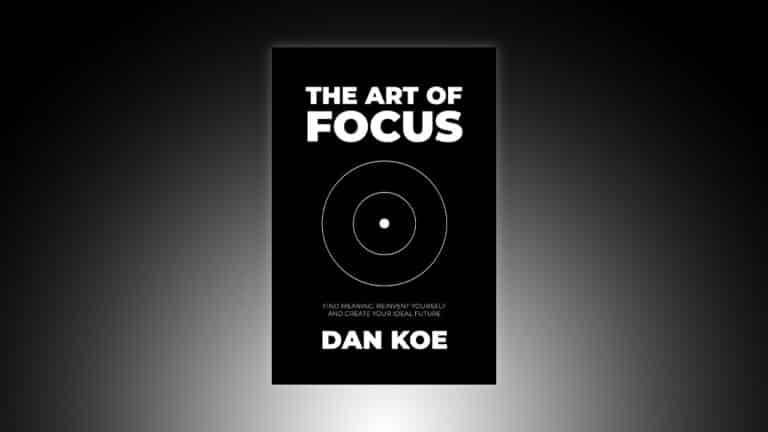Persuasion is the greatest skill of the 21st century.
No, persuasion is not manipulation. Two separate words.
No, persuasion is not unethical. If it were, then you would be the most unethical person on the planet because you persuade every day, but it’s unconscious to you, so at that point, it’s considered manipulation.
When you are trying to convince your friends to do something with you, you are using persuasion.
When you are presenting an argument for why people should work with you, you are using persuasion.
You are trying to get what you want out of life. You are playing the game of life. If you weren’t, you probably wouldn’t be alive. You don’t have a choice.
To get what you want, you need to persuade people to give you attention, resources, money, and most of all… power.
The only people who did well, and do well, in society are those who had power and influence.
They are people who work to acquire the resources necessary to achieve their goals, become valuable, and generate wealth.
There has never been a time in history when weak, average, or mindless people weren’t treated like cattle. Be careful of your mind trying to hijack your thoughts right now and make you a slave to the ideas others (that don’t have the life you want to live) programmed into your head.
Status, power, and influence aren’t bad. Everyone has them. Everyone is trying to get them. They become bad things when done for unconscious reasons. That is, when you don’t understand the big-picture impact of your pursuit of power through persuasion.
This entire letter could be completely negative, but if the overarching story and impact on your life is positive, does that make it a bad thing?
A side lesson on making better decisions: You will probably have to do things throughout your life that others will perceive as “bad,” “shallow,” or “superficial” because they don’t understand the big picture. They can’t see what you see. They criticize you now and praise you later. If you are deciding whether or not you should make a decision, zoom out and attempt to think through all possible scenarios it could create. As I’ve said before, one stock can be down while the index fund is up. You can have a cheat meal and still be healthy. Most just get neurotic over the cheat meal. And even if that decision turns out to be a mistake, welcome to being human, my friend. That’s the only way you can make a better decision the next time. Indecision, stagnation, and not pursuing something greater is the most “bad” decision of them all.
Back to the point.
If you want to be perceived as valuable, you need to generate power.
If your strategy for success is being nice and noble and spiritual, you will be pushed aside by mean people, and they will have more of an impact than you.
The people who virtue signal that power games are bad are playing their own power game. One that is selfish. One that lacks contribution to humanity. One that self-deceives into doing nothing but preaching about how others should change, distracting them from looking in the mirror.
After talking with many of you recently, I’ve narrowed down the reason you’re here.
You want work you enjoy, a meaningful lifestyle, and a bit more depth than the superficial content on the market right now.
Guess what?
In order to achieve any of those things, you need a certain degree of power.
You need people who pay you for your work.
You need people to listen to what you have to say.
You need a sense of control over the lifestyle you create.
You need to persuade more than just people, but reality itself to conspire in your favor. “Creating” your ideal life is persuading reality. You can’t force reality. You can’t deceive reality. But you can persuade it. That’s a sign of truth.
You inherently know that you need to learn to persuade to get what you want.
The only thing stopping you is the judgment of those who aren’t doing much with their life.
How To Start Persuading… Today
Structured thinking is important.
To handle an objection early:
No, frameworks and structures don’t strip you of your creativity.
Whenever I teach writing frameworks, social post frameworks, or how I write my newsletters, people ask valid questions.
“What if I don’t want to use a framework? What if I want to be authentic? What if I want to write whatever I want?”
(Note that I use “writing” as a way to persuade, but you can exchange that for speaking as well).
My answers:
- Do it. Write what you want. But organize your writing into a framework until you understand what makes writing impactful.
- Frameworks don’t hurt creativity. They enhance it. You can only be creative when you have a goal (something to be creative towards) and limitations that force creativity (like a framework). Building a business in 4 hours a day without sacrificing your health and relationships demands more creativity than building a business by giving up everything else in your life.
- You are using a framework already. It’s called your mind and how you were programmed to think. The thing is, it’s unconscious and clearly unimpactful, or else you would have the things you want in life.
Humans make sense of the world in stories.
They plug any idea or information they come across into their mind, a sense-making machine, that attempts to see how that information is relevant toward their goals and past experiences.
So, you can write whatever you want, but what’s the purpose of your writing or persuading?
To get what you want.
In other words, if there isn’t someone on the other end of your writing, it can’t really be persuasive, can it?
You will be using the methods below for nearly everything.
I challenge you to practice persuasion during every situation in your life going forward and see how your life changes.
- In your social posts, newsletters, and landing pages
- In your networking and sales calls or DMs
- In your relationships when attempting to make a decision
- Especially in your marketing and promotion of your work or products
Be intentional going forward.
Practice these at any chance you get.
The Pyramid Principle
The pyramid principle is a simple and effective way to communicate.
You can use it for anything.
Here’s how you do it:
- Start with your answer, conclusion, or big idea
- Prove your conclusion with 3+ key arguments
- Support your arguments with facts, data, anecdotes, quotes, etc
From a big-picture lens, that’s how all of my newsletters are written.
Does that make me inauthentic for not just writing chaotically? Or does it give me a vessel for articulating my thoughts in an impactful way?
You can notice that I often start with the point that I want to argue.
Then, I have a few sections of the newsletter where I break down arguments for that point.
Then, I often have tweets, quotes, or statistics to make those arguments more credible.
I have my own templates in Kortex for this. Before writing any newsletter, I write out my point, my arguments, and research that I can reference while writing. Then, that newsletter gets turned into a YouTube script. I’ll be updating 2 Hour Writer with Kortex templates when we launch.
Why does the pyramid principle work?
The reader knows immediately whether it’s relevant to them (the hook works).
They can follow your logic for how you got to that conclusion.
Lastly, it’s simple to replicate and use in everything.
State your point, explain why, and back it up.
Frameworks I Personally Use
I love starting with a pain point or problem in anything I write or speak about.
It makes the rest of my thoughts flow well.
It also frames the situation nicely and qualifies the reader.
When someone becomes aware of a pain point, their mind relates it to a goal in their life, sparking a desire to learn more and helping them know if my writing is for them or not. Then, the ones who stay want a solution, and if my solution is good enough, they’re more likely to stick around and invest in the further value I offer.
Remember: humans make sense of the world in stories. Stories usually start with a problem that foreshadows a “goal” or outcome. This makes your mind start filling in the blanks of that story and wanting to continue reading to see if it was right.
Here are a few frameworks to try, starting out simple and increasing in difficulty to pull off.
You can use 1 and 2 for social posts or the start of a long-form piece. You can use 3 for newsletters, landing pages, and other longer conversations like sales calls.
1) PP – Pain & Process
Pretty simple.
State the pain point and give a process to overcome it.
An example as a tweet:
If you’re tired all the time:
- Stop scrolling at midnight
- Fix your sh*tty nutrition
- Go on walks, move your body
- Become obsessed with a new interest
You’re tired because you’re trapped in a routine that has the outcome of being tired.
It’s wise to wrap all of these frameworks up with a conclusion or call to action.
Also, the more unique you can get with your solutions, the more impactful it becomes.
You are a dopamine dealer, so provide novel perspectives that others haven’t heard before. This requires you to be well-read about the topic or market you are writing about. It’s easy if you are a part of that marketing (*cough* You Are The Niche *cough*)
2) PAS(O) – Problem, Amplify, Solution, (Offer)
Similar story with this one.
You start with a pain point, but this time you amplify it.
You think deeply about how that pain point can spread into the rest of someone’s life.
Like how being tired can make your husband/wife think something is wrong and little problems start springing up out of nowhere. Or how you aren’t able to perform when trying to build your side hustle (will it ever work)? Or how when you get home from work, all you want to do is lie down and eat junk food, and that obviously isn’t helping you.
The more descriptive and relatable you can get, the better. A personal experience often works well in this scenario. So, if you have experience with the pain point, you can talk about how it impacted your life.
The “offer” portion of this framework is optional. If you are using it to write a social post, you don’t need the offer portion. If you are using the framework for a promotion, then position your offer as a novel solution to the pain point you targeted.
3) PASTOR – Problem, Amplify, Story, Testimony, Offer, Response
Again, very similar.
The PASTOR framework is a bit longer and is best used for promotional material like landing pages and emails.
When you are launching a product, running a sale, or just haven’t promoted yourself in a long time, use this framework.
Start with the problem.
Amplify it.
Give a personal or customer story as to how they overcame the problem. Hint at your unique solution.
Show proof via testimonials from others. If you don’t have testimonials, try showing proof via personal results or research and statistics.
Introduce your offer’s features and benefits opposing the pain points you illustrated before.
Ask them to do something next, like purchase.
4) Experimenting With Frameworks
The best way to learn persuasion is to:
- Research writing and speaking frameworks
- Write them down next to each other
- Practice them in the real world
- Notice patterns between them
- Break the rules
Frameworks, systems, and most education are training wheels.
Most people will read this letter, or another letter, or any other content and see someone with a “novel” solution to try out. This could be relationship advice, health practices, or business models.
They will adopt one strategy, make an identity out of it, and eventually get hurt when they realize they have to change how they do things as they make progress.
It is a very good thing that people are providing things to test and experiment with. It is a very bad thing when people take those things and act like they are the only way to get results.
So, to learn persuasion, research and write down 5-10 frameworks to try in your posts, conversations, newsletters, and the rest.
Then, drop the frameworks and use the principles that made them work in the first place to become a persuasive person at any time.
I teach my APAG framework inside 2 Hour Writer. That’s how I write these long letters that turn into long videos (that set me apart). Experiment with that framework if you’d like.
Know Who You’re Talking To
Your words will only persuade if you are speaking to someone who perceives your words as valuable.
If you are speaking high-level gibberish about a topic you are knowledgeable about, a beginner will not care about what you have to say. It’s hard for them to relate or understand.
We can solve this problem by understanding the 5 levels of awareness:
- Unaware – unaware of their problem and how it is hurting their quality of life. (Focus on pain points).
- Problem aware – aware of their problem but don’t know how to solve it. (Focus on the impact of those pain points).
- Solution aware – aware of their problem and know there is a solution, education, or knowledge to solve it. (Focus on actionable advice).
- Product aware – aware of their problem and know there is a streamlined path or system to solve it. (Focus on your unique way of doing things).
- Most aware – they are ready to change, they just need the right reason to act. (Focus on covering different angles – say 1 thing 1000 different ways).
In my newsletters, I often attempt to raise people up the entire chain. I assume people are unaware of their problem, so I state it at the top. Then, I dig into the problem and its impact on their life. Then, I present a step-by-step solution. Throughout the newsletter, I promote my relevant products or services.
In something like a social post, I usually focus on levels 1 through 3.
In social promotions (after the social post), I focus on 4 and 5.
From a very big picture, I treat my social posts (top of funnel) as a way to make people aware of problems. My newsletters and products do the rest of the work.
How I Write About What I Love, Persuasively
I want to show my process inside Kortex for writing with impact.
Of course, you can technically use any other note-taking or writing software to do this, especially since Kortex isn’t out (until late September for those on the waitlist.)
You see, we wanted to create a software that actually helped people think and write better. Most apps just throw you into a confusing environment. Your only option is to take notes how you always do – and we all know how many of your ideas get lost or aren’t understandable.
To start the process, we need four things:
- A topic to write about – preferably something that performs well. Find a topic that works on social media and use this process to make it your own.
- An idea dump – to get all of your ideas out and jot down new ones when they come to you (you won’t have all of your ideas at once).
- An outline page – To organize all of your ideas in a persuasive, impactful, and attention-grabbing way. (This is where most of your writing happens.)
- A draft page – To string together your ideas and outlines. This shouldn’t take long as the work is already done.
Here’s how my writing workflow looks in Kortex:
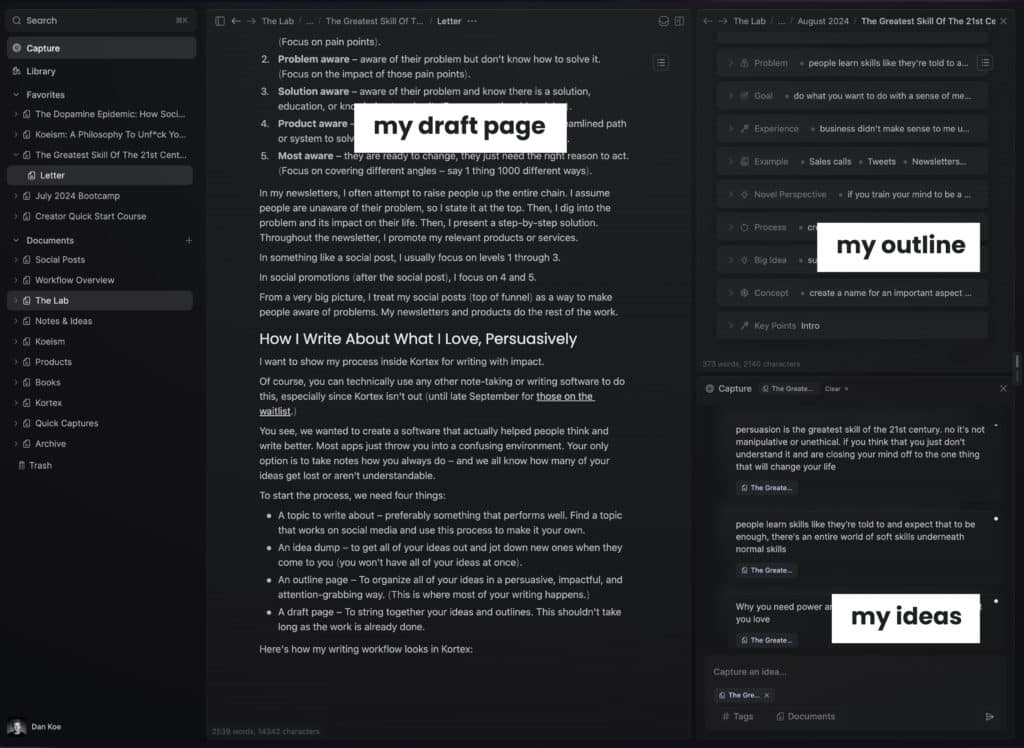
I start my outline at the beginning of each week.
I can capture ideas on my phone and attach them to that outline (think of how you would add a “todo” to a project in an app like Todoist).
The magic happens in my outline.
In the top right box of the screenshot above, we have a feature called “Elements.”
This is a simple feature that our students and users love the most.
In short, they are just custom call-out boxes that you can name, similar to Notion. But in Kortex, you can link to them, mirror them, and will eventually be able to add custom prompts to each element so AI can create your outlines in a few seconds (based on all of the knowledge you’ve stored in your second brain, so it’s unique to how you write).
Here’s what my blank weekly outline looks like with Elements.
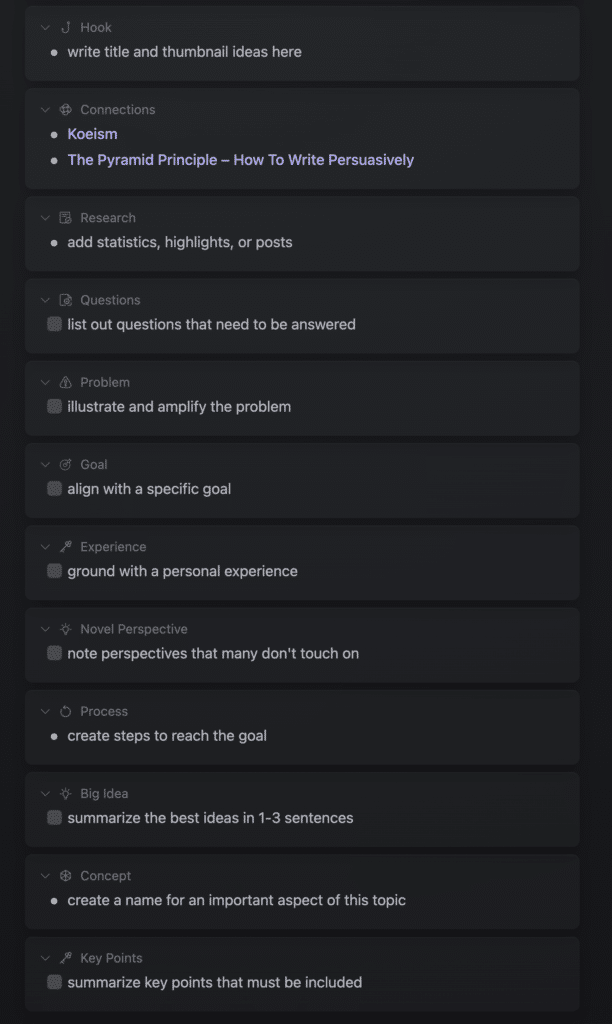
I brainstorm hooks at the top for YouTube titles and headlines.
I connect my relevant notes and ideas to navigate while writing.
I add tweets, quotes, and research to strengthen my argument and give me talking points.
(I store all of these in my Library that integrates with Readwise so I can save everything from Kindle highlights to Tweet bookmarks to web page clippings).
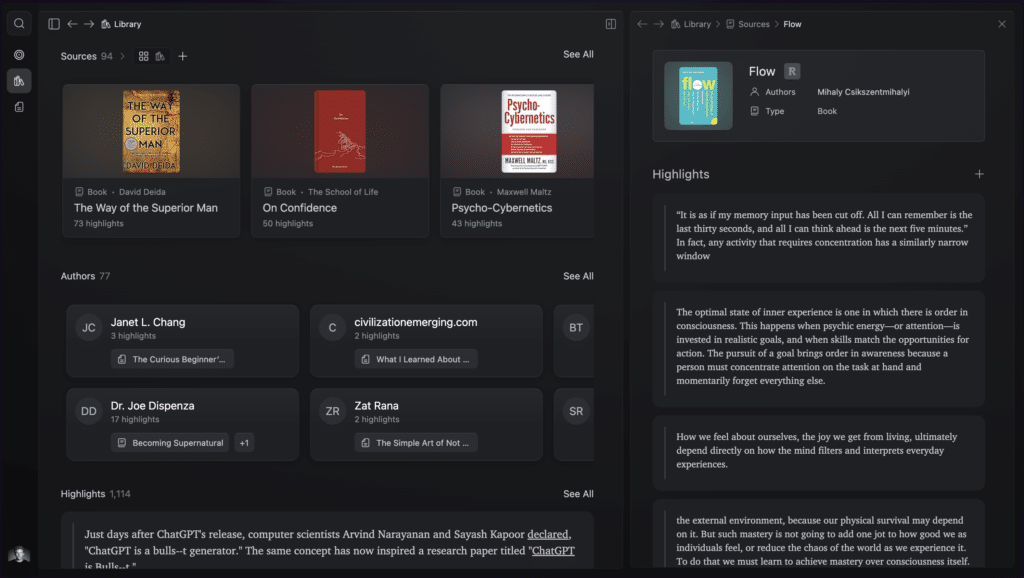
(You can see that I can open any of my highlights, documents, captures, outlines, etc in a pane on the left side to have everything in one view as I write – or I can go into focus mode.)
Then, I list out questions or objections to answer in the writing.
I illustrate and amplify the pain points or problems.
I brainstorm the goal or desired outcome.
I talk about my experiences for reliability, note novel perspectives, create actionable steps as the solution, summarize big ideas, and brainstorm potential concepts.
FYI, this is how I come up with all of my best YouTube videos.
My video “The One Person Business (How To Productize Yourself)” is just the “Concept (Process)” elements in my content outlines.
This is why the outlines and elements are so important.
You don’t learn to write persuasively, you learn to organize your thoughts persuasively, then the writing comes easy.
You can create this system with any note-taking app, but it may be difficult or take a lot of time. Or you’ll have to string 5 apps together.
This isn’t the sole purpose of Kortex, because I’m sure you can see how this will lead to journaling, productivity, and more content templates.
And that’s just the tip of the iceberg with Kortex.
So, to recap what you should do to start practicing your persuasion:
- Accept that you need power and status to break out of the hierarchy someone more powerful than you put you in.
- Use the Pyramid Principle as a starting point. State your point, argue your point, back up your point.
- Use a copywriting, content, or persuasion framework to structure your writing, speaking, or video scripts.
- Create an outline first based on that framework.
- Have a place to capture ideas (because the best ideas won’t come when you try to brainstorm them all).
- Start your draft. String together your outline ideas.
Then, post it in public so you can start getting data.
If people don’t engage, buy, or follow, you’re doing something wrong, and you probably need to educate yourself more beyond persuasion.
Here are a few places to start:
- How To Actually Grow On Social Media
- The One Person Foundations Mini Course
- Digital Economics or my other courses
That’s it for this letter.
Thank you for reading.
– Dan

